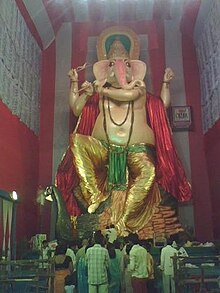Ganesh Chaturthi is the Hindu Festival celebrated on the birthday of the god Ganesha, the son of Shiva and Parvati. Ganesha is widely worshipped as the god of wisdom, prosperity and good fortune and traditionally invoked at the beginning of any new venture or at the start of travel. The festival, also known as Vinayaka Chaturthi ("festival of Ganesha") is observed in the Hindi calendar month of Bhaadrapada, starting on the shukla chaturthi (fourth day of the waxing moon period). The date usually falls between 19 August and 20 September. The festival lasts for 10 days, ending on Anant Chaturdashi (fourteenth day of the waxing moon period).
Wikipedia quoting over, the Ganesh festival is the most significant Hindu festival for Mumbaikars and is widely celebrated across the city. Ganesh can be recognised as the god with the head of the elephant - the story of how he got this is worth reading about but is a little long to repeat here. We have a small model of Ganesh covered by a red and gold cloth on the dashboard of our car (owned by Sagar) to bring good fortune. This is a very nice in principle, although the red cloth does seem to slip a lot and Sagar likes to rearrange it whilst driving, which can be a little unnerving at times.
As an outsider, my observations and consequential understanding of the Ganesh festival are as follows....For several weeks prior to the start date, Ganesh idols (of all sizes and level of decoration) and crafted and sold, ready to be displayed in homes and public places on the first day of the festival. Following this first day, these statues are processed and immersed in water on the 1st, 3rd, 5th, 7th or 11th day of the festival. At one extreme, a small clay statue will be immersed in a bucket at home and, at the other, huge statues are processed to the Arabian Sea and immersed by large groups of people. A scary number of people are said to drown during this process each year...
From what I've seen, the processions are joyful with lots of dancing, singing and extremely loud drumming. The scale and volume of the celebrations increases as the festival progresses and reaches its climax on the 11th day when the largest Ganeshas reach the sea. Throughout the festivals, we've been able to see fireworks and hear loud bangs from our apartment, as setting off firecrackers appears to be an exceptionally popular activity.
The area of the city in which we live has a large Muslim and Catholic population but, being on the coast, we were told that there would still be some Ganesh immersion activity on the final day. We went out yesterday evening to explore and saw a few processions and small crowds, though nothing too extreme. The heart of the action is elsewhere in the city, particularly at Juhu and Chowpatty beaches, although the crowds are supposed to be huge and we didn't explore those areas this time.
Here are some (rather blurry) pictures from our trip:
The largest Ganesh statue in India from 2011
Wikipedia quoting over, the Ganesh festival is the most significant Hindu festival for Mumbaikars and is widely celebrated across the city. Ganesh can be recognised as the god with the head of the elephant - the story of how he got this is worth reading about but is a little long to repeat here. We have a small model of Ganesh covered by a red and gold cloth on the dashboard of our car (owned by Sagar) to bring good fortune. This is a very nice in principle, although the red cloth does seem to slip a lot and Sagar likes to rearrange it whilst driving, which can be a little unnerving at times.
As an outsider, my observations and consequential understanding of the Ganesh festival are as follows....For several weeks prior to the start date, Ganesh idols (of all sizes and level of decoration) and crafted and sold, ready to be displayed in homes and public places on the first day of the festival. Following this first day, these statues are processed and immersed in water on the 1st, 3rd, 5th, 7th or 11th day of the festival. At one extreme, a small clay statue will be immersed in a bucket at home and, at the other, huge statues are processed to the Arabian Sea and immersed by large groups of people. A scary number of people are said to drown during this process each year...
Large Ganesh immersion
From what I've seen, the processions are joyful with lots of dancing, singing and extremely loud drumming. The scale and volume of the celebrations increases as the festival progresses and reaches its climax on the 11th day when the largest Ganeshas reach the sea. Throughout the festivals, we've been able to see fireworks and hear loud bangs from our apartment, as setting off firecrackers appears to be an exceptionally popular activity.
The area of the city in which we live has a large Muslim and Catholic population but, being on the coast, we were told that there would still be some Ganesh immersion activity on the final day. We went out yesterday evening to explore and saw a few processions and small crowds, though nothing too extreme. The heart of the action is elsewhere in the city, particularly at Juhu and Chowpatty beaches, although the crowds are supposed to be huge and we didn't explore those areas this time.
Here are some (rather blurry) pictures from our trip:
All traffic stopped for the procession
Ganesh covered in rice/grain confetti-type material
More procession
Decorated wagon
Another cheerful group on Bandra Bandstand







No comments:
Post a Comment